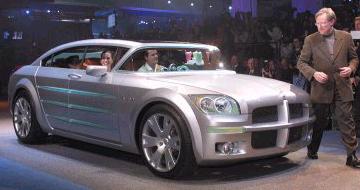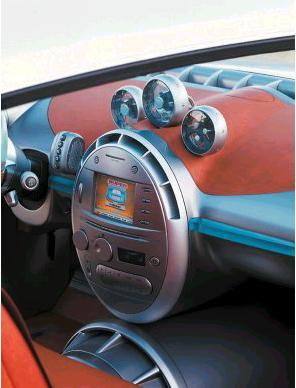Linux + Java turbocharge “Super8 Hemi” concept car
Jan 9, 2001 — by Rick Lehrbaum — from the LinuxDevices Archive — 4 viewsToday, DaimlerChrysler unveiled its newest concept car at the North American International Auto Show: the Dodge Super8 Hemi “all-American sedan” — with Linux and Java inside.
Freeman Thomas, the DaimlerChrysler VP who oversaw the Super8 Hemi's design, says the new car “embodies the culture and essence of American optimism. The . . . bold, in-your-face design shows our ability to embrace our love for the sedan and meld it with invigorating execution and technological advancement. With its distinctive tall stance, Hemi powertrain, and telematics applications throughout, the Super8 symbolizes everything we loved about sedans then, plus everything we need now.”

Dodge Super8 Hemi
“Everything we need now” apparently includes Linux and Java — because they're both embedded in the sexy new concept car's “Infotronic” system!
What's an Infotronic system?
DaimlerChrysler describes the Super8 Hemi's Infotronic system as “a state-of-the-art embedded computer system, which was designed to satisfy the never-ending thirst of tomorrow's automobile drivers and passengers for Internet-based data and information. The goal of the Infotronic system is to provide Infotainment, 'edutainment,' and entertainment services that meet the lifestyle of each individual driver or passenger.”
As you might expect, the system lets drivers and passengers browse the web, send and receive email, listen to MP3s and digital quality radio, play games, interact with smart home appliances, and run a variety of PDA-like applications.
The Super8 Hemi's Infotronic system was developed at the DaimlerChrysler Research and Technology Center (RTC) in Palo Alto, CA, in collaboration with Sun Microsystems. Dr. Wieland Holfelder, who manages the RTC's Smart Vehicles Group, explains the key objective of the system this way: “We believe our vehicles provide more than just transportation: they provide personal mobility to reflect our customers' lifestyles. Therefore, when a change in lifestyle occurs — such as the ubiquity of the Internet — we try to reflect that change in our products. With the Infotronic system on the Dodge Super8 Hemi, we prototyped how we at DC RTNA envision such lifestyle changes could affect our future products.”
System architecture
According to Holfelder, the vehicle's internal computing architecture consists of four Ethernet-networked PC-compatible computers. Three of the computers serve as passenger terminals — one in the front seat, and two in the rear (one for each rear passenger). The fourth functions as a network server and communications gateway.
Each computer contains a miniature (PC/104 based) PC compatible computer board running Red Hat Linux 6.2. At the moment, the concept car prototypes contain large amounts of system RAM (128MB) along with multi-gigabyte disk storage, in order to ease the pain of the software developers. Although that may seem excessive, such capacities are likely to be the stuff of PDAs by the time the cars arrive in consumer driveways!
The front-seat system (photo, below) has a 6.4″ LCD display and uses pushbuttons and speech recognition as user input controls, no doubt to discourage drivers from taking their hands off the wheel. Voice commands let drivers keep their eyes on the road and hands on the wheel while controlling the in-vehicle audio system, climate control, security system, and phone, or while accessing remote information or devices via the Internet. The two rear-seat systems have 8.4″ LCD touch-screen displays, mounted on arms attached to the front seat backrests.

Dashboard-mounted Infotronic Control Panel
Off-board communication is managed by the server/gateway computer system, and makes use of a combination of three wireless interfaces — CDPD cellular modem, Ricochet wireless, and IEEE-802.11 wireless. 802.11, being limited to short-range distances, provides a convenient means of transferring data to and from the owner's home computing environment when the vehicle is parked at home. Its primary use is to load up the car system with passengers' favorite multimedia files, email, and other data.
In addition to the Linux operating system, a certified standard Java Virtual Machine (JVM) from Sun equipped with Espial's DeviceTop environment provides a software platform for Java-based applications. All of the system's software components are written in Java, for ease of development and maximum portability. Espial's Java-written browser and email client are used in the prototypes, along with a host of DaimlerChrysler-developed in-car applications.
Why Linux? Why Java?
The project team chose Linux primarily due to the requirement for complete and unencumbered access to all low level drivers — something much easier and simpler to do with Linux than with most other operating systems. Also, the stability and reliability of Linux were considered strong pluses, in comparison with other options.
As a result of using Java as an application platform, these factors were far more important than the presence or absence of any particular Linux-based application software. In fact, the Infotronic system's Java-written applications were designed so that they can (in principle) be run on any OS that has a JVM.
According to Holfelder, a whitepaper with detailed technical information about the Infotronic system's internal architecture will be published on January 24.
This article was originally published on LinuxDevices.com and has been donated to the open source community by QuinStreet Inc. Please visit LinuxToday.com for up-to-date news and articles about Linux and open source.